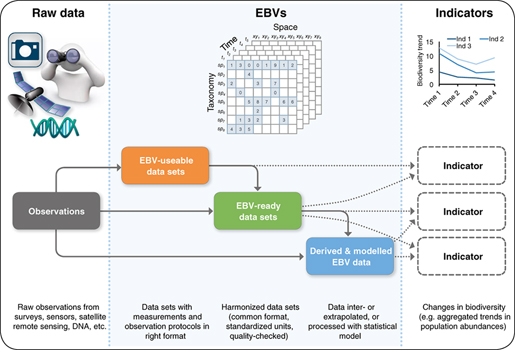Much biodiversity data is collected worldwide, but it remains challenging to assemble the scattered knowledge for assessing biodiversity status and trends. The concept of Essential Biodiversity Variables (EBVs) was introduced to structure biodiversity monitoring globally, and to harmonize and standardize biodiversity data from disparate sources to capture a minimum set of critical variables required to study, report and manage biodiversity change. Here, the challenges of a ‘Big Data' approach to building global EBV data products across taxa and spatiotemporal scales is assessed, focusing on species distribution and abundance. The majority of currently available data on species distributions derives from incidentally reported observations or from surveys where presence-only or presence–absence data are sampled repeatedly with standardized protocols. Most abundance data come from opportunistic population counts or from population time series using standardized protocols (e.g. repeated surveys of the same population from single or multiple sites). Enormous complexity exists in integrating these heterogeneous, multi-source data sets across space, time, taxa and different sampling methods. Integration of such data into global EBV data products requires correcting biases introduced by imperfect detection and varying sampling effort, dealing with different spatial resolution and extents, harmonizing measurement units from different data sources or sampling methods, applying statistical tools and models for spatial inter- or extrapolation, and quantifying sources of uncertainty and errors in data and models. To support the development of EBVs by the Group on Earth Observations Biodiversity Observation Network (GEO BON), 11 key workflow steps are identified that will operationalize the process of building EBV data products within and across research infrastructures worldwide. These workflow steps take multiple sequential activities into account, including identification and aggregation of various raw data sources, data quality control, taxonomic name matching and statistical modelling of integrated data. These steps are illustrated with concrete examples from existing citizen science and professional monitoring projects, including eBird, the Tropical Ecology Assessment and Monitoring network, the Living Planet Index and the Baltic Sea zooplankton monitoring. The identified workflow steps are applicable to both terrestrial and aquatic systems and a broad range of spatial, temporal and taxonomic scales. They depend on clear, findable and accessible metadata, and an overview of current data and metadata standards is provided. Several challenges remain to be solved for building global EBV data products: (i) developing tools and models for combining heterogeneous, multi-source data sets and filling data gaps in geographic, temporal and taxonomic coverage, (ii) integrating emerging methods and technologies for data collection such as citizen science, sensor networks, DNA-based techniques and satellite remote sensing, (iii) solving major technical issues related to data product structure, data storage, execution of workflows and the production process/cycle as well as approaching technical interoperability among research infrastructures, (iv) allowing semantic interoperability by developing and adopting standards and tools for capturing consistent data and metadata, and (v) ensuring legal interoperability by endorsing open data or data that are free from restrictions on use, modification and sharing. Addressing these challenges is critical for biodiversity research and for assessing progress towards conservation policy targets and sustainable development goals. informacion[at]ebd.csic.es: Kissling et al (2017) Building essential biodiversity variables (EBVs) of species distribution and abundance at a global scale. Biol Rev Doi 10.1111/brv.12359
http://onlinelibrary.wiley.com/doi/10.1111/brv.12359/abstract


 Las altas temperaturas están provocando que las lagunas y las marismas de Doñana pierdan agua rápidamente
Las altas temperaturas están provocando que las lagunas y las marismas de Doñana pierdan agua rápidamente




